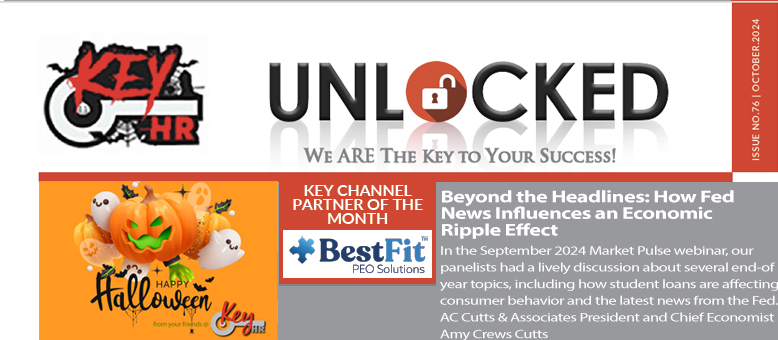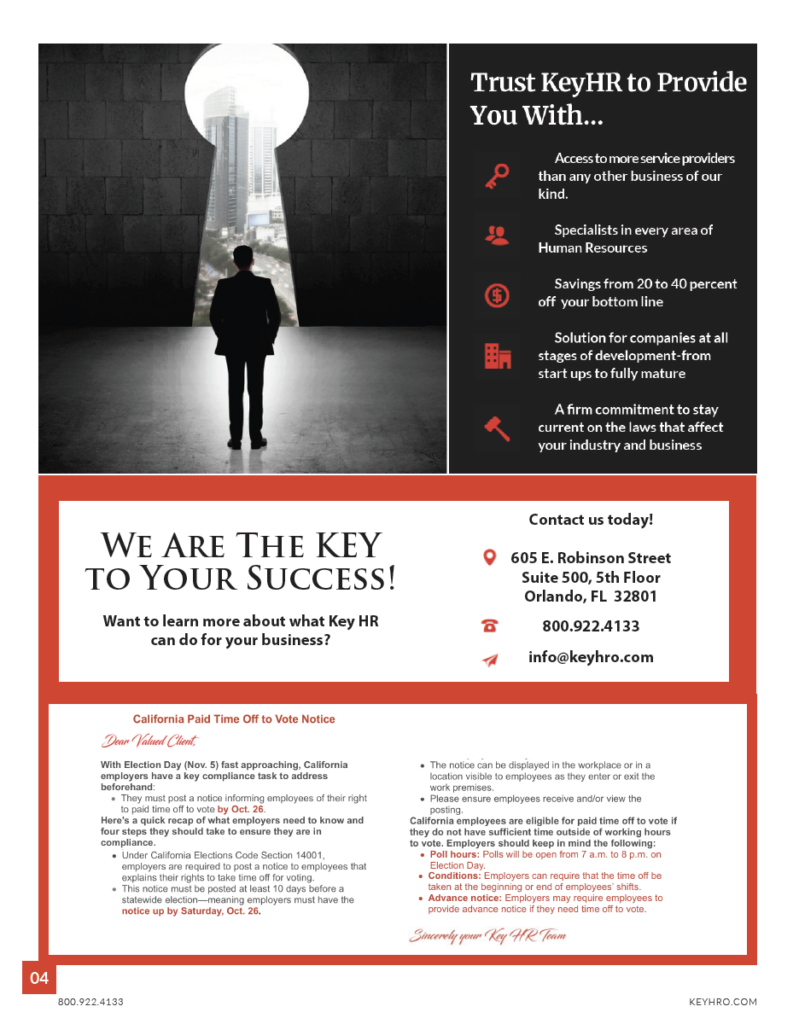
KEY HR UNLOCKED Newsletter – ISSUE NO. 76 | OCTOBER . 2024


How successful could you be if you could focus on what you do best? It’s a question worth asking. And we not only HAVE the answer… We ARE the Key!
KeyHR is aligned with preferred provider companies to offer new and innovative ways to meet out clients’ payroll, employee leasing, benefits and insurance needs.
Our relationship with these companies helps business owners reduce costs, save time, optimize their workforce, increase revenue and minimize risk. If your company needs to save money, address compliance issues, improve efficiencies and increase productivity, we have the solutions.
If your company needs to save money, address compliance issues, improve efficiencies and increase productivity, we have the solutions and the key to your success.
Trust Key HR to provide you with…

- Access to more service providers than any other business of our kind
- Specialists in every area of Human Resources
- Solutions for companies at all stages of development – from startups to fully mature
- A firm commitment to stay current on the laws that affect your industry and business
- Savings from 20 to 40 percent off your bottom line
- It could be one of the smartest business decisions you ever make!

Beyond the Headlines: How Fed News Influences an Economic Ripple Effect
In the September 2024 Market Pulse webinar, our panelists had a lively discussion about several end-of-year topics, including how student loans are affecting consumer behavior and the latest news from the Fed. AC Cutts & Associates President and Chief Economist Amy Crews Cutts covered a dynamic macroeconomic update around the latest Fed rate cut — and what it signals. Later, she was joined by Equifax Risk Advisors, Jesse Hardin, David Sojka, Maria Urtubey, and Tom O’Neill, for a discussion in response to your questions about even more year-end topics. Separately, we broke down consumer credit trends.
Macroeconomic Observations and Updates with Amy Crews Cutts, President and Chief Economist, AC Cutts & Associates One of the most anticipated financial events of the quarter was the Fed’s announcement about rate cuts in response to inflation. As that result was finally reported, we have the reactions, implications, and possible outcomes.
The Fed’s Rate Cut With inflation “moving sustainably toward 2%” the Federal Open Market Committee (FOMC) decided to “lower the target range for the federal funds rate by ½ percentage point to 4-¾ to 5%.”At first, the stock market responded positively to the announcement; however, that reaction quickly turned into a new realization: This means the Fed is more concerned with recession than inflation. For some background, inflation is measured using a basket of goods, including estimates like “owner equivalent rent” for homeowners, which can create some discrepancies in shelter measurements. Therefore, the shelter component of inflation is currently elevated due to lagging data. However, the Federal Reserve believes that excluding energy, food, and shelter, inflation is nearing the target of 2%. At this level, inflation tends to go unnoticed by the public as it reflects normal fluctuations in the economy. When it comes to employment, the unemployment rate has risen slightly to just over 4% in a gradual manner, with overall employment growth slowing. This situation led the Fed to decide to cut interest rates, with the size of the cut being somewhat surprising.
Rate Cut Implications While some might feel light relief from this cut, many will feel nothing at all.
Other Important Areas to Watch While the economy settles post-rate cut, there are two other areas of possible concern:
- A looming government shutdown
- A recent port strike
With a deadline of December 20, 2024, Congress must reach a budget deal to prevent a federal government shutdown on December 21, 2024. Moreover, a shutdown is not ideal in an election year, so there could be a flurry of last-minute negotiations. Regarding the ports, a strike could mean billions of lost dollars and logistical ramifications that would carry a significant impact on the economy and overall supply chain. Cutts also took a deep dive into the intricacies behind changes in the yield curve and employment numbers as they relate to this cut. You can see those charts by viewing the presentation.
Discussion on the Big Picture: Analysis on Fed News and Consumer Spending Our panel of experts not only discussed top-of-mind issues as we head into Q4 2024, but they also took audience questions in real time. Below is a summary of this session, but you can read the full question and answer blog. Recent drops in rates on CDs indicate potential relief for consumers, particularly in revolving credit products, while fintech companies may see improved funding and increased loan originations following the recent 50 basis point rate cuts. Moreover, there’s complexity within the market due to the Fed rate cut. Specifically, lenders are having difficulty with pricing, while consumers carefully consider when to take out a loan. In our K-shaped economy, there is no clear distinction between those who are thriving and those who are struggling.
equifax.com

Seasonal Hiring Demand Falls
Back Down to Pre-Pandemic Level
Job seeker interest in holiday work remains elevated
Holiday job postings for seasonal positions are back to 2019 levels, but job seeker interest in these roles is the highest in years, meaning greater competition is in store for applicants.
As of Sept. 24, job postings for seasonal positions were 0.5% higher than they were on the same day in 2019 but still 12% lower than a 2021 peak, according to data from Indeed. Job postings in retail are particularly strong, accounting for 66% of all seasonal postings and up nearly eight percentage points from last year’s share.
“Historically, postings for seasonal workers start ramping up in September and peak in November, offering a preview of what we can expect as we head into the holidays,” said Allison Shrivastava, an associate economist with the Indeed Hiring Lab. “Demand for holiday jobs has returned to pre-pandemic levels, offering a welcome reprieve from the overheated post-pandemic labor market of 2021. While employers aren’t entering the holidays with new pessimism, the hiring frenzy of recent years has certainly cooled off.”
On the other side of the employment equation, job searches for seasonal holiday work have surpassed their pre-pandemic base line. “Any lingering concerns about COVID-19 exposure through in-person work like retail, seem to have abated, as searches for seasonal jobs as a share of total searches reached their highest levels in recent years,” Shrivastava said. “However, this increased interest comes alongside fewer opportunities than in 2022 and 2021, which means greater competition for seasonal positions.”
She added that the seasonal hiring outlook resembles the broader labor market—an abundance of interested talent contrasted with slowed-down demand.
Retail Hiring Outlook
Strong retail staffing announcements kicked off the holiday hiring season in September, alongside initial projections for retail sales to grow modestly.
Retailers appear to be preparing for a strong spending season while inflation is cooling, but so is consumer spending, according to global outplacement/career transition business and executive coaching firm Challenger, Gray & Christmas (“Challenger”).
A cooling labor market may lead to fewer hires than in previous years, according to Challenger’s analysis of data from the U.S. Bureau of Labor Statistics. The firm predicts that retailers will add 520,000 new jobs in Q4, the second-lowest total since 2009 and below last year’s roughly 564,000 jobs.
“This prediction considers that now, job gains are falling and consumers have tightened spending,” said Andrew Challenger, senior vice president at Challenger. “That said, the cooling seems to be slow. Seasonal employers will add jobs, but need may fluctuate as the season progresses.”
Challenger has tracked 334,850 seasonal hiring plans this year. A few of the large-scale hiring announcements include Amazon planning to employ 250,000 additional workers, particularly in fulfillment and transportation; Target hiring 100,000 seasonal employees for its stores and supply centers; and the United Parcel Service looking to bring on more than 125,000 seasonal workers.
The transportation and warehousing sector added 336,400 seasonal workers last year, according to Challenger. The sector added 552,300 seasonal employees in 2021, the most ever.
“Transportation, shipping, and warehousing may not see the dramatic seasonal hiring spikes of previous years due to ongoing staffing stabilization and the increased use of automation,” Andrew Challenger said. “As companies navigate these evolving conditions, the flexibility to adapt to changing demand will be key in determining the final outcomes of seasonal hiring efforts. Ultimately, while the hiring landscape may be less aggressive than in recent years, it remains an essential part of the holiday economy.”
www.shrm.org

Work stress has reached crisis levels across every generation. Employees’ work stress has an outsized effect on the business, eroding productivity, absenteeism and retention. For the employees themselves, this stress doesn’t evaporate when they take the elevator down from the office. Work stress often follows employees home, negatively impacting their mental health, sleep, diet and interpersonal relationships. HR and benefits professionals should consider applying these five strategies to mitigate its impact:
1. Focus on progress – not perfection – in pursuing a redefined work-life balance
Employers must foster an environment where employees feel comfortable identifying their priorities and creating space away from work – both physically and mentally. Employers can build structures and policies that support basic needs, which contribute to our collective mental health. What seems like small accommodations are actually foundational to building and promoting employee resilience and longevity. Although sleep takes place outside of working hours, employers can provide education and resources to aid sleep hygiene and quality sleep. They also can reinforce the value of work-life boundaries (e.g., not expecting employees to send communications at night or outside of work hours), thereby promoting the value of rest.
2. Leverage the power of relationships and human connection Improved mental health relies largely on finding and building social connections in our lives. Time spent working dominates a significant amount of our waking hours: about one-third of our lives. It also serves as an optimal setting for facilitating connection. In today’s increasingly virtual workplaces, it is imperative to begin on day one of an employee’s journey, by creating a warm onboarding experience that includes dedicating time to large and small team meetings, to introducing and celebrating new employees joining the organization.
3. Encourage peer-to-peer and intergenerational mentorship It’s remarkable how people of all generations form unexpected friendships with colleagues and connect in ways they might not typically outside of work. As someone who sits on the cusp of a generation – between millennials and Gen X – I’ve experienced first-hand the power of connecting with co-workers across all age demographics. When Taylor Swift dropped her latest album, I was just as giddy as some of my Gen Z colleagues to swap favorite songs.
4. Explore modernized EAPs to provide mental health support for employees Employee assistance programs (EAPs) are designed to provide immediate access to employees struggling with their mental health, but the reality is that EAPs are terribly underutilized, with engagement rates generally hovering around 3% to 5%, and often lower. Effective EAPs help employees take care of their mental health before it reaches a breaking point. They have a greater chance of utilization when they go beyond traditional therapy support. That means providing real-time access to a coach and self-care content, such as mindfulness practices and other skill-building exercises.
5. Share the load between employees and employers People don’t show up for work as clean slates. They are coded with genetic vulnerabilities, differences in the prenatal environment and early childhood experiences that collide with the stressors of life events. The combination of these variables plays a significant role in the quality and durability of our mental health and resilience.
Work has an outsized role in contributing to the stress in our lives, but the stress resolution can’t rest exclusively on employees’ shoulders. Employers have to recognize their role in the mental health dynamic and do their part to help. Leaders need to be cognizant of the amount of stressors that are embedded in an employee’s work structure and seek to reduce the workplace total stress quotient through practices like clear communication, promotion of employees utilizing time off, and ongoing system improvements to reduce tasks and administrative burdens. Agile businesses need to take a proactive, rather than a reactive, approach to employee mental health. It is in employers’ best interests to find common ground, foster greater community and in turn, create happy, healthy workplaces.
benefitnews.com

Click To download the Key HR Newsletter UNCLOCKED
_________________________________
This communication is for informational purposes only; it is not legal, tax or
accounting advice; and is not an offer to sell, buy or procure insurance.
This post may contain hyperlinks to websites operated by parties other than KeyHR. Such hyperlinks
are provided for reference only. KeyHR does not control such websites and is not responsible for their content.
Inclusion of such hyperlinks on KeyHRO.com does not necessarily imply any endorsement of the material
on such websites or association with their operators
- Posted by admin
- On October 18, 2024
- 0 Comment




